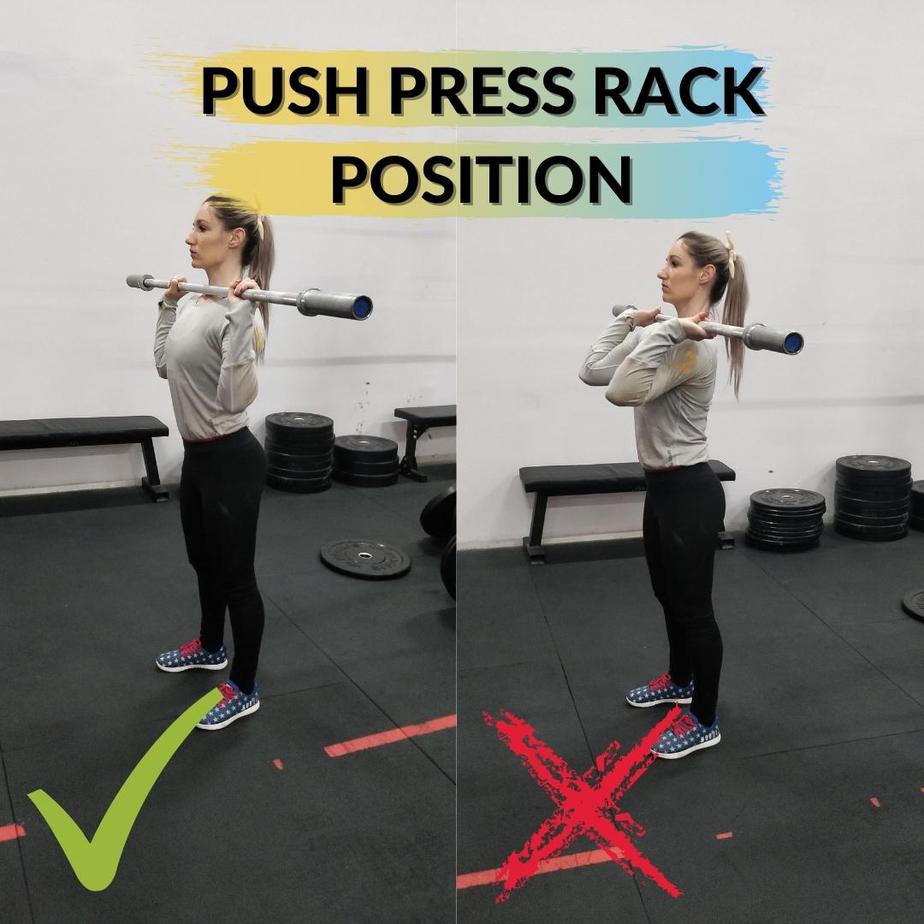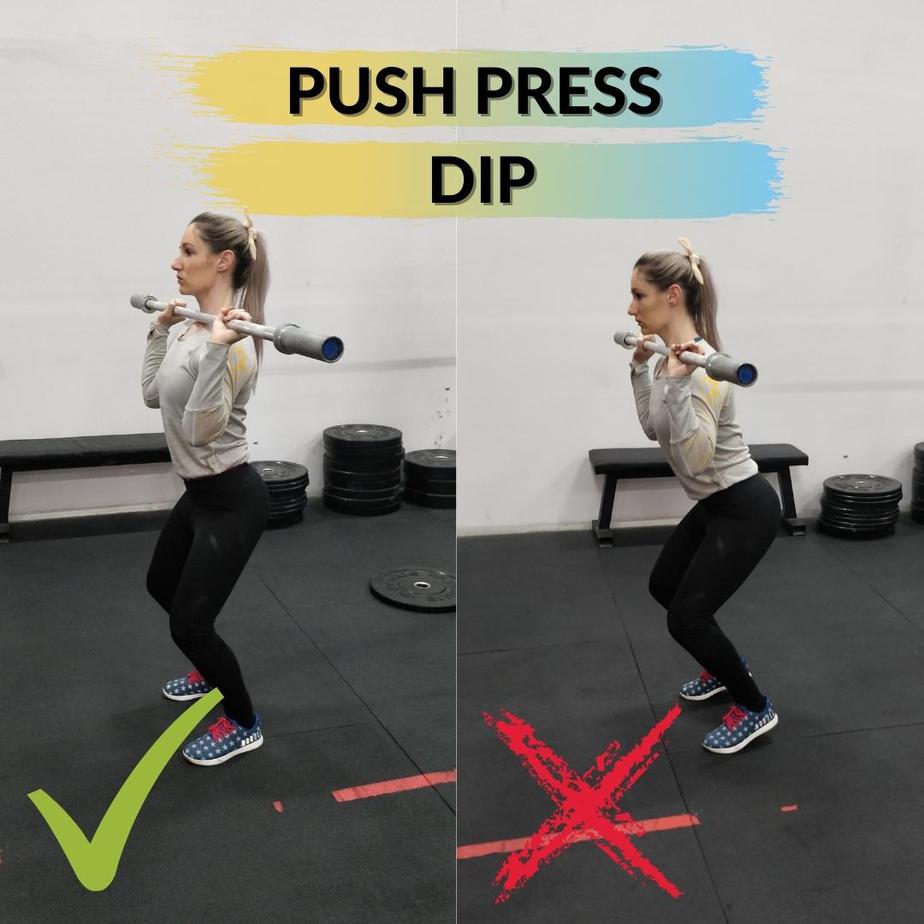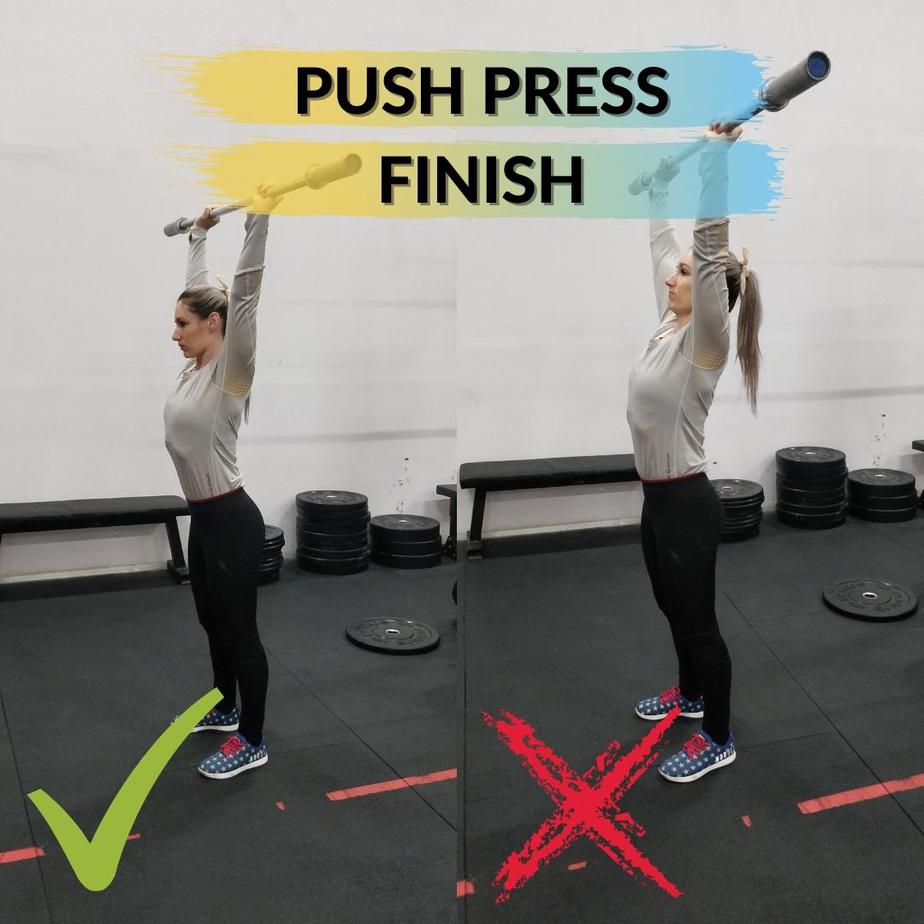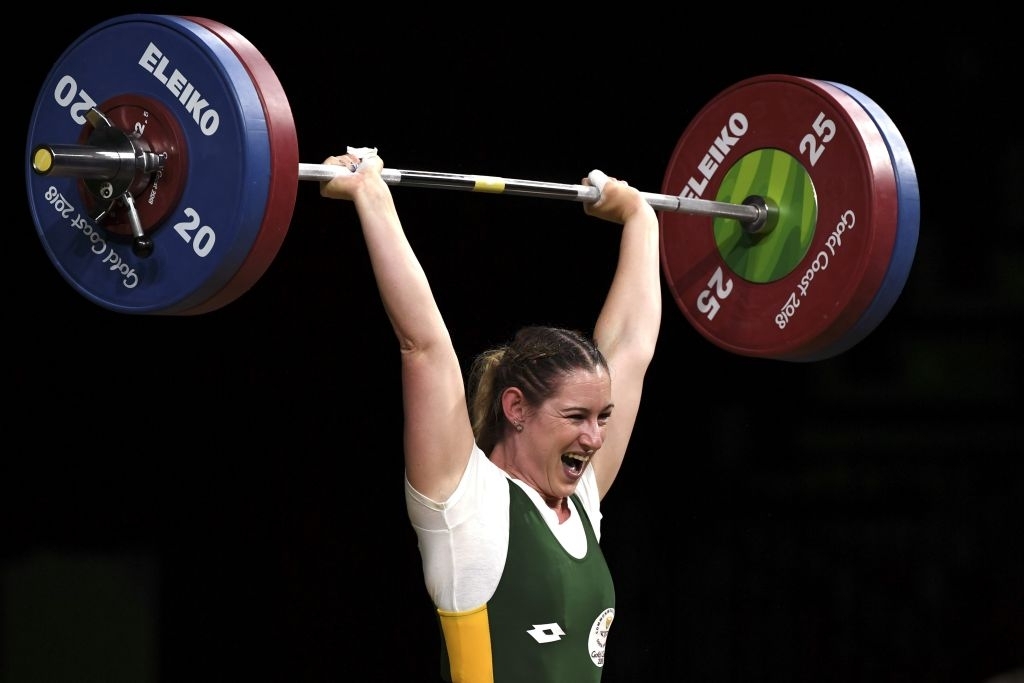The most common accessory exercise for the jerk is the push press. And for good reason. It has all of the same characteristics as the jerk without having to worry about the split position.
This article will specifically cover the push press with the barbell even though it can also be performed with dumbbells and kettlebells. So, let’s get straight into how to perform the push press.
Table of Contents
How To Perform The Push Press
The Rack Position
There are two ways you can get the bar to the rack position.
Performing a power clean before the push press turns it into a different exercise, the power clean and push press. So, I will be explaining the push press like you’ve taken it from the rack.
The setup for the rack position should be exactly the same as setting up for a front squat when taking the bar out of the rack. Barbell on the shoulders against the neck, elbows high, and the hands either holding the barbell or the fingers under the bar with an open hand.
Once the bar is taken out of the rack and you’re set in a straight leg stance, lower the elbows slightly so you can create a more vertical forearm position. This creates a stronger line of force by keeping your arms under the barbell from the beginning.
If you leave your elbows high like a front squat, you can't push from the beginning on the push press.
It's important that even though the elbows are slightly lowered, the chest remains high to keep the upright posture. It can be easy to drop the chest when the elbows also drop so it’s important to be mindful of it.

The Dip & Drive
This is where it is make or break for the push press. A great dip will set you up for big weights. A poor dip will leave you using loads you can only strict press.
The dip begins with the weight towards your heels with the full foot contacting the ground. By keeping the weight close to or on the heels, the dip remains straight. If the body weight is too far forward in the foot when beginning the dip, it'll cause you to dip forward losing the ability to push the bar vertically.
The dip should be initiated by dipping the tailbone straight down to the floor. You can think of pulling a piece of string attached to your tailbone straight down.
The knees will bend and travel slightly outwards like you would when squatting.
Many Weightlifters will make the mistake of only bending the knees forward. This reduces the stability of the dip and leaks energy as the knees travel too far forward throwing the weight towards to toes too early.
The depth of the dip will be similar to a quarter squat depth or slightly higher. You will need to feel this one out.
Once the bottom of the dip is reached, a sharp and explosive drive phase is initiated where you will push through the full foot and eventually finish with straight legs extending onto your toes.
A good analogy is thinking of your dip as a spring. You pull yourself down into quarter squat depth and rebound into the drive.
Make sure to pull your head back as you go to drive the barbell otherwise you may hit your chin. You’re likely to do it once in your Weightlifting career but once you’ve done it, you will never do it again.

The Finish
As the barbell travels off the shoulders from the leg drive, you must push simultaneously with the arms. The force generated from the legs AND the arms is what allows you to press much heavier weight overhead than a press.
Continue pressing with the shoulders, arms, and legs as the bar travels overhead. It should stay close to the face and follow the same trajectory as your normal press or jerk.
It’s important that once you get to triple extension of the hips, knees, and ankles, you don’t stay on your toes for the entire push press. You will lower back down to a flat-footed position as you continue to press the barbell.
The legs will remain straight throughout the rest of the lift and the finish. Re-bending the legs changes the exercise to a push jerk which is not what we are after.
The end position will have the barbell overhead with the head through to create a stable lockout position. To lower the barbell back to the shoulders, bend the knees slightly first to receive and ride the bar down.
This is very similar to how you would catch a thruster but without squatting so far down. Before performing another rep, the legs must be straight.

What Muscles Does The Push Press Work?
Quadriceps
The forceful dip and drive are what lights the quads up. If you've gone heavy in the push press, you may have felt major delayed onset muscle soreness the following day in your vastus medialis or teardrop.
The powerful extension of the knee puts a lot of stress on the quads.
Calf/Ankle Complex
The calf is involved in the final push of the lower body triple extension. After the powerful quads have extended the knee and glutes have extended the hips, the calves flex the ankle to drive the barbell off of the shoulders.
Erector Spinae
The large columns of muscle on each side of the spine act isometrically through the whole exercise. Isometric means tension with no change in muscle length. Strong erector spinae are important as they allow you to handle heavy loads on the shoulders without losing an upright posture.
Shoulders
While the push press has help from the legs, it doesn’t take away the heavy contribution from the shoulders. The legs allow greater loads to be pressed overhead. But the shoulders still have to do their part to finish the lift by continuing the momentum and getting the barbell overhead.
Triceps
The triceps add the finishing touches to the pressing movement. Once the barbell clears the sticking point anywhere between the nose and just above the head, the triceps need to be strong to lock the elbows out.
Benefits Of The Push Press
Strengthen The Dip For The Jerk
The push press reinforces how to drive the barbell up like they would when performing the jerk. Performing the jerk is the obvious way to get better at jerking. However, you can’t perform multiple days of jerks each week due to staleness and the potential to start developing overuse pain.
The push press is a variation where you can still train the exact dip and drive as you would when jerking without the impact force of the jerk.
Handle Heavier Loads Than The Press
The push press is the perfect exercise to overload the shoulders. No other exercise will allow you to press heavier weight overhead.
Weightlifters will use the push press to strengthen the shoulders and triceps when handling heavy jerks.
When Should You Use The Push Press?
The push press makes the perfect upper body accessory lift after a Weightlifting session. It’s not as taxing as various pulls so it can be done after a tough session even though it is technically a full-body movement.
Beginners also benefit from the push press as a progression from the press. This is part of the teaching continuum before teaching the split jerk. It gives the beginner Weightlifter a feel for the dip and drive without having to worry about the split position.
Finally, the push press is a great exercise primer to use before your jerk session. It can be done in a jerk complex such as push press + jerk or on its own.
How Many Sets And Reps Of The Push Press?
Generally, the push press is programmed as 3-6 sets of 3-5 reps at approximately 60-80% of your 1RM jerk. Reps can also go as low as 1-2 when going for a maximum or generally pushing heavy weight.
High reps aren’t typically conducive to the push press due to how quickly fatigue sets in limiting the load that can be used.
Push Press Variations
Behind The Neck
The behind the neck variation of the push press is used to reinforce a straight bar path especially for Weightlifters that tend to drive the barbell forward in their jerk. It’s also great for Weightlifters that struggle to dip straight down as it forces the athlete to dip straight and drive the barbell up and back.
There is also a behind the neck push press variation with a snatch grip. This variation isn’t to train the jerk, but rather develop strength in the overhead position specifically for the snatch.
Paused Dip
Pausing in the dip position with the push press removes the stretch-shortening cycle from the dip and drive taking away the elastic energy that contributes to the drive of the lift.
No elastic energy means more stress is placed on the muscles to produce force. This can help create a stronger drive phase. Further, pausing in the dip position provides immediate feedback for athletes that struggle to dip straight down.
If they dip forward with a pause, they will feel their bodyweight is forward in a weak position and can correct it.

 (@powerfulpretorius)
(@powerfulpretorius)